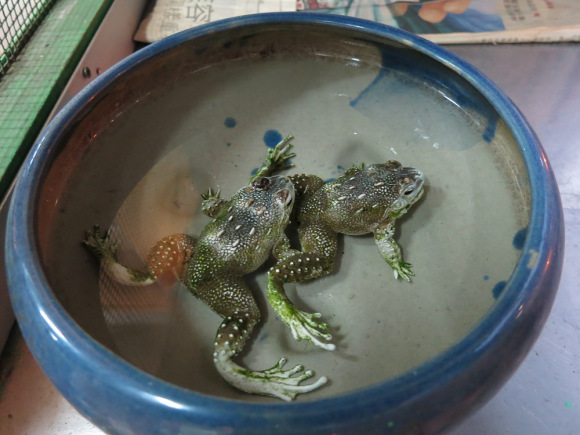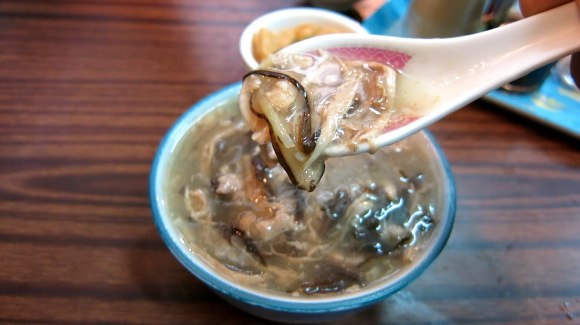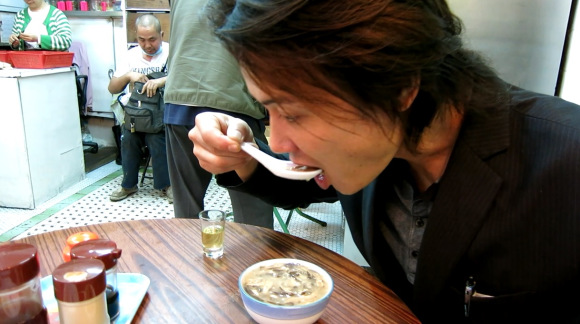 Rachel TackettApr 18, 2013
Rachel TackettApr 18, 2013

Have you ever heard the phrase “you are what you eat”? Perhaps this is why every region has its own brand of “soul food,” embodying the heart and history of its people. For Japan, the most basic and invigorating dishes you can find would probably be nattoand miso soup. But how about the powerhouse city of Hong Kong? Apparently, and much to our surprise, Hong Kong’s home-grown food for the soul is snake soup! Before hearing of this, the thought of eating a snake had never really crossed our minds, but we couldn’t help but be curious about the taste. And so, we took to the streets of Hong Kong in search of a restaurant that would sell us some freshly prepared snake.
After asking around for some recommendations, we were introduced to a restaurant that, from the outside, looked more like a pharmacy than an eating establishment. But sure enough, when we went inside to place our order, they were selling snake soup, just as the locals informed us.
The snakes used in the soup were bred by the restaurant and kept live in a tank in front of the shop. There was also a container of frogs used as snake food. While we did notice a few little frogs who had managed to hop free, for the poor creatures left in their cages, reptile and amphibians alike, it was only a matter of time before they were destined to be devoured…
So when our soup was brought to the table, we must have been expecting something like an entire snake coiled up in the bottom of a bowl of broth, but what we were given, much to our relief, was a really delicious-looking thick and creamy dish. Moreover, the snake meat was finely sliced and mixed up with a number of other ingredients. We’re told that a single bowl of soup can contain between three and five different species of snakes! We also found pieces of cloud ear mushroom, shiitake, and bits of ginger, giving the soup a very pleasant aroma.
But even more important than the soup’s appearance; the flavor was fantastic. The rich taste was better than any fish we’ve ever had but was still mild enough that it was easy to eat it all. If people were to add snake meat to sara udon (Japanese plated noodle dish similar to chow mein), that would make such a nice fit! Honestly, any Japanese restaurant could benefit from putting snake on the menu!
According to the local folk lore, eating snake meat in the fall invigorates the soul and restores strength to the body. Eating such delicious food at the peak of the season gives people the power and drive to work hard through the winter cold, in true Hong Kong fashion.
Of course, eating snake isn’t limited to just Hong Kong. It’s quite common throughout China, as well as Taiwan and many other Asian countries. Even within Japan, rangers in the Ground Self-Defense Forces are taught how to cook and eat snakes as part of their training. Certainly, there will always be some individuals who are fundamentally repulsed by the idea of eating snakes. However, it is our recommendation that if you ever take a trip to Hong Kong, do try at least one bowl of snake soup. You won’t be disappointed by the flavor, and just think of the extra power and vitality that it will lend you!
Pictures: RocketNews24
▼Here’s a picture of the restaurant’s exterior. It really looks more like a drug store!
▼These frogs may not realize it, but this the countdown to the end of their lives, when they both become snake food.
▼Here’s what the snake meat looked like mixed into the soup.
▼”This is delicious! I’d love to try it in other things!”
▼We’d like to give a big thank you to Kazusa (15) for helping us with this report!
“The white pieces are the snake” “So I just dip and eat it?” “This snake is delicious! It’s better than fish!” “Please, eat up!” “Today I’ll be having a lot of snake soup and sweet sake. Thank you!”
The restaurant that we ate at is called SEE WONG YAN (蛇王恩). Here’s a map for those who are interested in giving it a try.
I'm a culinary enthusiast with a deep understanding of various regional cuisines, and I've personally explored the intricate world of unique dishes. Now, let's delve into the fascinating article about Hong Kong's soul food – snake soup.
In Hong Kong, snake soup is considered a local delicacy, and it serves as a testament to the city's culinary diversity. The article mentions two primary ingredients – natto and miso soup – representing Japan's soul food. However, in Hong Kong, snake soup takes center stage.
The article describes the surprising revelation of snake soup as Hong Kong's soul food. The writer embarks on a quest to find a restaurant that serves freshly prepared snake soup, highlighting the unique culinary experience awaiting adventurous diners. The restaurant, which outwardly resembles a pharmacy, turns out to be a hub for this exotic dish.
Live snakes are bred by the restaurant and kept in a tank, creating a visually intriguing atmosphere for customers. The soup itself is described as a thick and creamy dish, containing finely sliced snake meat along with various other ingredients like cloud ear mushroom, shiitake, and ginger. Notably, a single bowl may feature three to five different species of snakes.
The flavor is reported to be rich and better than any fish, offering a mild taste that makes it easy to enjoy. The article suggests that adding snake meat to dishes like sara udon (a Japanese plated noodle dish) could create a delightful combination. The piece also touches on the folklore belief that consuming snake meat in the fall invigorates the soul and restores strength to the body, providing the energy to endure the winter cold in true Hong Kong fashion.
Furthermore, the article mentions that snake consumption is not exclusive to Hong Kong but is common in various Asian countries, including China and Taiwan. Even in Japan, certain groups, like the Ground Self-Defense Forces rangers, are taught how to cook and eat snakes as part of their training.
In conclusion, the culinary adventure described in the article encourages readers to be open-minded about trying snake soup if they ever visit Hong Kong. The enticing description of the flavor, coupled with the cultural significance attached to snake consumption, adds a layer of intrigue to the city's culinary landscape. The restaurant, SEE WONG YAN (蛇王恩), is recommended for those eager to embark on this unique gastronomic journey.





